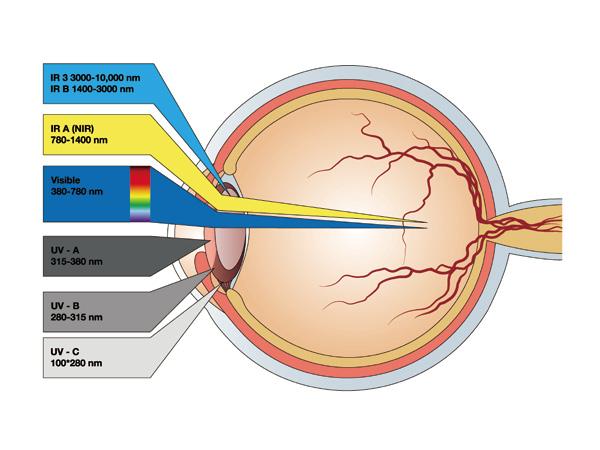Laser Safety Eyewear- Laser Safety World©
Laser Safety Eyewear- Laser Safety World©
Laser Safety World© eyewear are manufactured with material of polycarbonate (except for p/n CDE and p/n ADEF-D5T90 made of glasses material ), compliant with European laser safety standards EN207, and are provided with high level of protection from laser radiation. High optical density(OD) and visible light transmittance(VLT) for its lens, the glasses have no optical distortion and are not easy to scratch. Laser Safety World© eyewear are widely applied to many areas: laser manufacture, scientific research, laser alignment system, medical and cosmetic facilities.
Standards and Test:
Laser Safety World© eyewear are tested based on standards EN207&EN167, and are compliant with CMA and ilac-MRA, accreditation system which have been integrated to international mutual recognition. It means the Laser Safety World© eyewear are also compliant with CE standards, and meet the threshold of European market.
Frame Style:You can choose from the follow up three styles
Strap-up Classic Clip-on

*Classic Style: regular standard style, large surrounding, eyeglass arms adjustable, available to wear prescription glasses, suitable for most persons and applications.
*Clip-on Style: clamped and fixed on the prescription glasses, available to be flipped up, but increase the weight of frames causing a possibility of falling.
*Strap-up Style: fully surrounded and protected, no worries about eyewear falling, but not comfortable to wear prescription glasses together.
Selections:please read the following table.
OD (optical density) is the amount of light attenuated by the lens of different particular wavelength that is being measured, e.g.OD4 means a light transmittance of 1/10000, and so on. For more details of OD value of each particular wavelength, please refer to the test report.
VLT(visible light transmittance) is the amount of visible light(400-700nm) that can pass through the lens of a pair of glasses. More informally, it means the clearness of the lens of glasses, the higher the VLT value, the clearer the glasses.
|
P/N |
Application |
OD |
VLT |
Photo |
|
A-D4T50 |
UV, Blue laser |
OD6+@190-378nm OD5+@379-463nm |
50% |
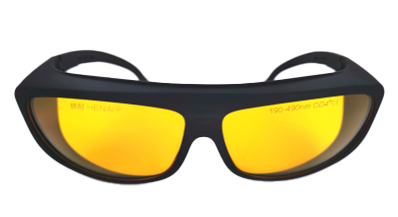 |
|
AB-D5T35 |
UV, Blue laser, Green laser, Wavelength 532nm. |
OD7+@190-350nm |
35% |
 |
|
AY-D5T15 |
YELLOW |
OD3+@560-574nm OD4+@574-575nm OD5+@575-596nm OD3+@596-600nm |
15% |
 |
|
AC-D5T35 |
UV, Red laser, Wavelength 630nm, 660nm |
OD6+@190-280nm OD5+@280-383nm OD4+@383-400nm OD3+@600-630nm OD4+@630-720nm |
35% |
 |
|
ACD-D5T70 |
Red laser, Wavelength 755nm, 808nm, 810nm |
OD6+@190-380nm |
70% |
 |
|
AD-D5T60 |
Fiber, IR, wavelength 1064nm, and low light environments |
OD7+@190-280nm |
60% |
 |
|
ADE-D4T35 |
Fiber IR, Wavelength 1064nm, laser welding/cutting/cleaning |
OD7+@190-400nm |
35% |
 |
|
ABD-D5T35 |
Fiber IR, laser welding/cutting/cleaning, and wavelength 532nm &1064nm. |
OD7+@190-280nm |
35% |
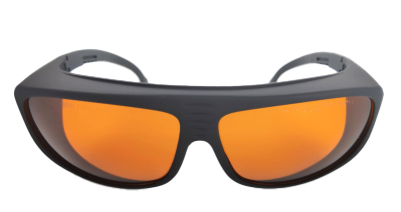 |
|
ABD-D8T10 |
Better version of ABD-D5T35 |
OD7+@190-510nm OD6+@510-535nm OD5+@535-540nm OD3+@540-546nm OD5+@800-840nm OD6+@840-1019nm OD7+@1019-1100nm OD9+@1064nm |
10% |
 |
|
ADEF-D5T40 |
Fiber IR, Wavelength 1064nm、1319nm、1540nm |
OD7+@190-280nm |
40% |
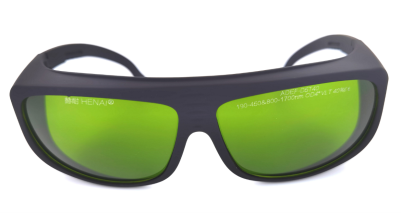 |
|
CD-D6T25 |
Visible light, Near IR |
OD2+@600-625nm OD3+@625-635nm OD4+@635-641nm OD5+@641-645nm OD6+@645-649nm OD7+@649-710nm OD4+@710-760nm OD5+@760-773nm OD6+@773-800nm OD5+@800-900nm OD6+@900-1050nm OD7+@1050-1100nm |
25% |
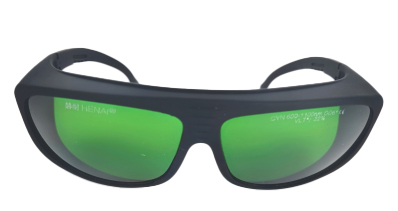 |
|
CDE |
Laser devices with red laser pointer. |
OD2+@640-660nm |
40% |
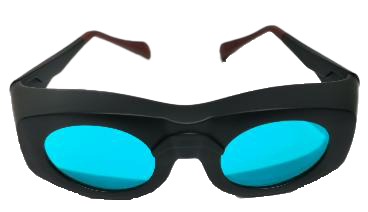 |
|
ADEF-D5T90 |
Medical, Optical communication, Wavelength 1319nm、1550nm、2100nm、2780nm、2940nm |
OD6+@190-265nm |
90% |
 |
|
BGR |
UV, Blue laser, Red laser, Green laser, Laser pointer, Wavelength 445、450、473、515、520、532、635、660 |
OD3+@190-400nm |
25% |
 |
|
CO2-D5T50 |
CO2 laser |
OD6+@10600nm |
50% |
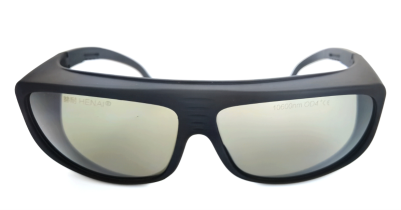 |
|
CO2-D5T90 |
CO2 laser |
OD6+@10600nm |
90% |
 |
|
IPL |
Intense pulsed laser |
OD4+@190~2000nm |
30% |
 |
Hazards of laser radiation to human eyes:
The damages of laser radiation to eyes will cause the photokeratitis, corneal coagulation, carbonization and perforation, lens cloudiness, visual dysfunction “flash blindness” and retinal coagulation, bleeding, and rupture. When the visible light with high intensity or near-infrared light enters the eye, it can pass through the human eye refractive medium and focus light onto the retina. At this time, the laser energy density on the retina reaches to thousands or even tens of thousands of times, and a large amount of light energy is instantly focused on the retina, causing the temperature of the photoreceptor cell layer of the retina to rise rapidly, resulting in photoreceptor cell coagulation degeneration necrosis and loss of photosensitive function.
